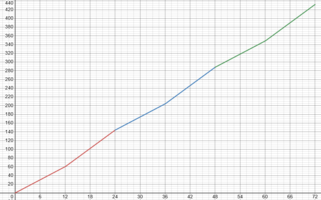Hi Joisarri. In algebra, we always define our symbols first. That way, we can see if our expressions make sense.
Your equation above implies that you may be thinking x represents 1hr and y represents $1. That won't work because we cannot multiply
24*1hr by
5*$1. (The result would be 120hour-dollars.)
Within the first 12 hours, I'm thinking something like this:
Let x = elasped time (in hours)
Let y = total money received at time x (in dollars)
y = 5x
So, are you trying to come up with a formula where you substitute
any number of elapsed hours (for x), to get the value of y at that point?
If so, then are you also incorporating the formula within software that you're developing?
I ask because the growth rate of money received changes after 12 hours (from $5/hr to $7/hr), and that situation requires what's known as a piecewise construction – one formula used when x goes from 0 through 12 and a second formula when x is greater than 12.
Please provide more details about why you desire the formula (i.e., what you plan to do with it). Also, if this is schoolwork, then please provide the complete text of the project statement. We can go from there. Cheers!

PS: We're using x as a variable, so let's not use X as a multiplication sign. Use an asterisk, instead.
[imath]\;[/imath]

